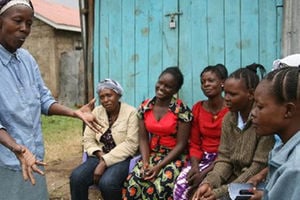
Transitioning from an informal table banking group to a serious investment group requires a certain level of seriousness and formality.
We’ve all heard a variety of chama stories. For some, chamas have been a gateway to high-value investments, but to others, not so much was yielded. Take Jane, for instance. When she joined her first chama, she was excited by the possibilities. It was a group of 20 and she would be the last person to receive her share. She contributed the required monthly Sh1,500, faithfully but when it was her turn to get the group savings, the treasurer disappeared with the money.
For Jeniffer, joining a chama with friends from her neighbourhood was one of the best decisions she has ever made. She developed financial discipline and was able to access urgent loans when her family needed them. She invested her money in several projects and she also built a community of friends who became a pillar of support for years. But along the way, she had a fallout with a member and their conflict began driving a wedge between other group members. Eventually, she had to walk away.
That said, chamas and other group investments are underrated investment vehicles. This week, we look into how chamas can transition from just saving and table banking ventures to formal groups capable of investing in income-generating property. What does it really take to move past the casualness, the conflicts and the fear of loss? DN2 Property talked to three experts and here’s their take:
Formalising the group
Transitioning from an informal table banking group to a serious investment group requires a certain level of seriousness and formality. Besides, informal groups are limited by law on the kind of economic activities they can participate in. Formalising a group starts with registering with the relevant authority. And though chamas have many options when it comes to registration, there are factors to consider. Advocate David Mwangi advises a registration option that allows your group to buy and own property. In addition, the leadership and individual members must be protected from legal liability in case of debts or lawsuits.
Mwangi further explains that a chama can be registered as a community-based organisation (CBO) or a self-help group under the Ministry of Labour and Social Protection. The registration process for this category of groups is quite streamlined with accessible resources across sub-counties and Huduma Centres countrywide. The only downside is that registration certificates for community groups must be renewed each year, and the group must submit quarterly progress reports to the registering authority.
There is also an option to register the group as a limited liability company (LLC). An LLC has notable advantages. For starters, the company is a legal entity, meaning individual members do not take liability for the company’s debt or legal problems. An LLC can also hold property and the registration framework provides a clear membership or shareholding structure. The registration process is also quite straightforward and can be done online through the Business Registration Services. On the negative side, registering a company comes with legal obligations. For instance, the company has to file annual returns, a fact that adds to the group’s burdens. This, however, pushes the group to maintain proper account books, a key ingredient to success in group investing. In case of conflict and one of the company’s director’s decides to exit, they have to go through a formal process of resigning and having their details removed from the companies’ registrar. Exits, conflict and succession should however be anticipated and dealt with through a constitution.
What to include in a chama constitution
A constitution is a document that outlines the rules of operation and governance. With the rise of formal investment groups, there are many entities providing constitution templates. These templates cover the basics and can be customised to suit your group’s needs. Alternatively, the group can consult an advocate to advise on some of the legal issues that should be covered in the constitution.
However, there are critical elements to include in this important document. The constitution has to lay down the leadership and membership structure as well as the rights and obligations of each member. Additionally, be sure to capture the decision-making process and the decision makers. Profit and loss sharing rules should also be spelt out clearly, based on contributions and responsibilities assigned to members.
Turning savings into investments
Christabel Ojuok , an Asset Manager (Property), and the Chief Operating Officer at Rentscore Africa, says the most common pitfalls when it comes to chama investments include the absence of a clear long-term vision to guide the investment strategy. Most chamas start casually and many fail to strategise on what they want. Most groups also lack a formal structure or legal entity status to protect their investment. And an even more common pitfall includes failing to treat investments as a serious income-generating business, which leads to voluntary roles without accountability. “The overall leader should receive compensation, even if minimal, to ensure accountability,” says Ojuok, adding that it is important to engage a professional estate agent who can provide detailed financial projections. This will ensure they understand the full cost implications of an investment, operating expenses, and potential investment returns, along with valuable market insights.

Christabel Ojuok. She is an Asset Manager (Property) and the Chief Operating Officer at Rentscore Africa.
Closing costs
In real estate transactions for instance, there are several closing costs as well as taxes and operating costs which are never captured in property prices. Ojuok estimates that closing costs are likely to add up to about 7.5 percent of the property price, for cash buyers. Stamp duty for instance amounts to 4 percent of the property value within a municipality and 2 percent outside municipality in rural areas.
Legal fees also make part of closing costs and Ojuok explains these are twofold. “As a buyer, you will pay the developer’s or seller’s advocate and typically it ranges from 1 percent to 2 percent of the property cost. If you come in with your own advocate, that is an extra cost, but you have the leeway to negotiate your fees. There are other minor closing costs such as the fees for incorporating the management company which manages the common areas within a development. These fees are not fixed, and it depends on the development. In most instances you are also required to pay service charge several months in advance. There may be a cost for registration of sectional plans if the property is an apartment unit and the costs vary from one property to another.”
In addition to these closing costs, property investments also attract taxes. You will pay Land rents and rates as well as rental income tax of 7.5 percent. However, with rental income tax, there's a threshold amount you have to make as a landlord to pay the tax. For mortgage buyers, the cost of servicing the mortgage also comes into play.
Breaking down the numbers
When it comes to saving and investment timelines, chamas have to factor in the value of time and how affordability or property prices shift. Ojuok says, “Property prices are driven by factors such as land costs, construction expenses, and profit margins. In the second quarter of 2024, for instance, Nairobi saw a 1 percent rise in property prices, down from 2.7 percent in quarter one. Despite this slower growth, property prices have increased for the eighth consecutive period, indicating ongoing market stability. With this in mind and using the investment example below, one year of savings is enough for an investment group to begin their real estate venture before they are priced out of certain markets or properties”.
A real estate investment group composed of middle income earners should aim for a monthly contribution of Sh100,000, which could be Sh10,000 per member in a group of 10. After 12 months, they’ll have enough to make a 30 percent deposit (Sh900,000) on a quality 27 square metre, studio apartment worth Sh3 million, located in a high-demand short-stay neighbourhood. Buying off-plan is more affordable and with a two-year payment plan, monthly instalments of Sh87,500 will be covered by their contributions, and they will also have sufficient funds to cover closing costs and Sh400,000 for furnishing.
Furnishing the apartment and renting it out for short-term (or long-term stays) optimises the property’s returns. It is highly advisable to work with a professional interior designer to maximise occupancy rates and attract referrals. Be sure to ask the developer if furnished apartments are allowed within the project as some sellers restrict buyers from going into this business depending on the property type.
Optimising returns
At a daily rate of Sh3,500 and a 65 percent occupancy rate, Ojuok projects that the group will earn a net income of Sh51,188, achieving a rental yield of 17 percent. This accounts for the purchase price, closing costs, furnishing costs, and management fees at 25 percent (including utilities). With technology, they can install a smart lock with a new password for each check-in, to prevent revenue leakage. Revenue leakages in short-stay business are often caused by unaccounted guests. “In a case where they get a manager, depending on who they work with, the manager can easily book the property and not let the group know. But with a smart lock the group will have insight on every booking. Given the volatile nature of the short-term stay rental business, the group can exit after five years. The Internal Rate of Return (IRR) will be approximately 19.63 percent, with an equity multiple of 1.97 times, meaning they will have made a 97 percent profit over that period”.
IRR is a metric used to calculate returns in investment, it factors in the time value of money - the duration of the money - cumulatively how much you made in returns over a certain period.
For a group that does not want to go into the furnished apartment businesses, it is advisable to get a larger unit such as a one or two-bedroom more suited for the long-term rental market. “The biggest challenge in renting a studio to one long-term tenant is that you are relying on students or low income tenants and the income can be unreliable,” Ojuok notes
Getting the right property
When shopping for properties to buy, it is advisable to work with an agent who understands market trends and the property landscape. Common considerations include the property’s location, the specific placement of the development, current supply of similar properties (both existing and upcoming), and nearby amenities. “The unit's price in relation to its potential rental income is also important, as this will directly impact your return on investment. The development mix also determines the ease of attracting tenants. For instance, placing a studio next to a 3-bedroom could cause conflicts due to differences in the target clientele”
To borrow or not to borrow?
Due to the capital intensive nature of real estate investments, sometimes groups may consider seeking a financier. On this issue, Ojuok says an elite investment group contributing Sh1M or more monthly is better positioned to seek financing for building capital-intensive real estate projects, either residential or commercial.
“These types of investments often yield strong returns, especially when utilising a mix of debt and equity. To maximise returns, the group can save in a SACCO, they earn dividends and shop around for the most affordable loan options. It's also crucial to identify the break-even occupancy rate in their financial projections. If for example 70 percent of the units are rented out and the rental income can meet their debt, then it's okay to seek financing, but if they have to get 100 percent occupancy rate to meet debt expenses then a loan would be too risky.
Going digital

Humphrey Obell.
Beyond the lack of knowledge on how to invest, chamas also struggle with issues such as lack of transparency, inability to keep proper account books and the time constraints that come with meeting too often. In light of this, several tech companies in Kenya have come up with digital solutions to help chamas streamline their operations. Bluecrane Creatives is one of those companies with their platform Chama Expert developed by three partners Humphrey Obell, Daniel Makonga and Tobias Okoth. DN2 Property also spoke to one of the co-founder, Obell on the factors to consider when incorporating tech in your chama. As Obell explains, professionalising a chama by digitising operations helps in securing long-term success and sustainability. “When a chama operates informally, it often lacks structure, making it difficult to scale or access larger investment opportunities. By incorporating technology, chamas build trust and accountability, and it becomes easier to make strategic decision-making.”
“We developed Chama Expert after observing the challenges that many Kenyan chamas face in organising their operations, handling finances. The lack of transparency, accountability, proper record-keeping and communication breakdown often result in mismanagement or mistrust which can lead to the downfall of many promising groups. We wanted to create a solution that could transform how chamas operate, leveraging technology to make group investments more efficient, secure, and scalable”
Chama Expert provides a platform where members can monitor their contributions in real-time, track investment growth, and have a clear overview of the group's financial health. It also helps automate processes like record-keeping, dividend sharing, and reporting.
Choosing a platform
When selecting a tech platform, Obell advises chama members to consider the platform’s security, ease of use, scalability, and features that meet the group’s unique needs. “Security is paramount, especially when handling group funds, so a platform with strong encryption and data protection is essential. Additionally, the platform should be user-friendly, especially if some chama members are not tech-savvy. The ability to grow with the platform is also important, whether it's for small savings or larger investment portfolios, the platform should cater to the evolving needs of the group. Lastly, look for platforms that offer transparency features, such as real-time financial tracking and reporting tools.”







